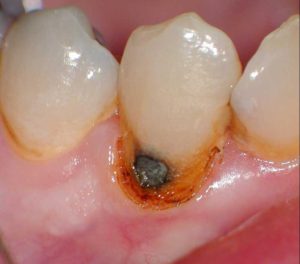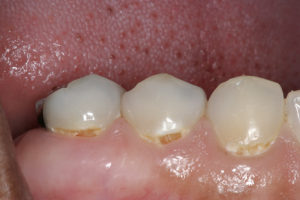Cervical caries develops in the neck of the tooth, one of the most vulnerable parts of the tooth site where the coronal part of the tooth makes connection with the gums.
It starts as a rough white chalk zone, which generates that more plaque can adhere to this area, then go dark until it forms a cavity.
Symptoms begin as areas that are more sensitive to changes in temperature in the mouth, an area that is clearly whiter or of different color that is becoming dark or black. To end in pain from nerve involvement.
In its initial stage it is treated with remineralization of dental enamel.
If there is already a deeper effect on the enamel, it performs the cleaning and removal of the damaged enamel and a resin filling is made of the same color as the tooth to restore its function and shape.
If there is nerve involvement, a root canal is performed and the filling made for the affected cervical area.
La caries cervical se desarrolla en el cuello del diente, una de las partes más vulnerables del diente sitio donde la parte coronal del diente hace conexión con las encías.
El cuello del diente está cubierto por una fina capa de esmalte, lo que lo hace más susceptible a caries y lesiones más rápidas.
Inicia como una zona blanco tiza, áspera, lo que genera que más placa se puede adherir a esta zona, para luego ir tornándose oscura hasta formar una cavidad.
Los síntomas inician como zonas más sensibles a los cambios de temperatura en la boca, se observa una zona claramente mas blanca o de diferente color que se va tornando oscura o negra. Para terminar en dolor por afectación del nervio.
Como tratarla la caries cervical:
En su etapa inicial se trata con remineralización del esmalte dental.
Si ya existe un efecto más profundo en el esmalte su realiza la limpieza y remoción del esmalte dañado y se realiza una calza de resina del mismo color del diente.
Si hay afectación del nervio se realiza el tratamiento de nervio y la calza para la zona del cuello afectada.
No related posts.













Leave Your Response